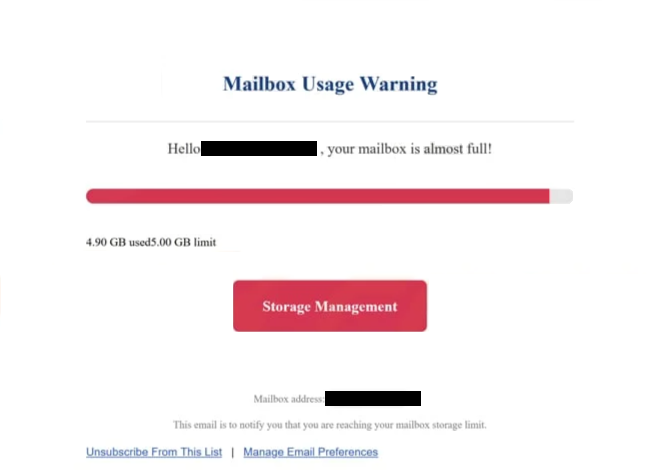Remove “Mailbox Usage Warning” email
The “Mailbox Usage Warning” email is part of a phishing campaign that targets users’ email login credentials. The email is disguised as a notification from the email service provider, informing users that their inboxes are almost full. The email does not contain a lot of information, but it implies that recipients need to free up space to continue receiving and sending emails. If users engage with the email, they will be taken to a phishing site that asks them to log in to their email accounts. If they type in their passwords, they will be stolen, allowing malicious actors to access their email accounts.
The “Mailbox Usage Warning” email is a generic phishing email. It’s made to look like a notification from the email service provider and supposedly informs users that their email storage is almost full. The email’s subject line also says that users will soon not be able to send or receive emails, implying that they need to free up storage. The email has a “Storage Management” button, which will lead users to a phishing site if clicked.
The phishing site is a poor imitation of the Gmail login page. The site displays a message saying there was some authentication error, and a pop-up saying users need to type in their Gmail passwords to access secured settings. If users type in their passwords, they will be stolen. Malicious actors operating this phishing campaign may use the stolen login credentials themselves or sell them to other cybercriminals.
Email account credentials are among the most sought-after information by cybercriminals. Email accounts are connected to many other accounts, and gaining access to an email account could allow one to access all connected accounts as well. What’s more, if users are not in the habit of deleting sensitive emails, an inbox could contain a lot of highly sensitive information.
If users have interacted with this “Mailbox Usage Warning” or similar email, they need to immediately change their passwords if their accounts can still be accessed. If the accounts are no longer accessible and no account recovery options work, users need to disconnect the email from all accounts to prevent them from being taken over.
What are the signs of a phishing email?
Most phishing emails targeting everyday users are fairly generic and relatively easy to recognize. They typically have multiple indicators that reveal their malicious intent, so as long as users are aware of what to look for, they should be able to recognize them without much trouble. In contrast, more sophisticated phishing attempts tend to target high-profile individuals whose personal information may have been compromised. These tailored malicious emails usually have no grammar mistakes, reference credible information, and appear highly professional. Thankfully, most users are unlikely to be targets of these advanced attacks.
When you receive an unsolicited email urging you to click a link or open an attachment, the first step is to verify whether the sender’s email address belongs to whom they claim to be. Low-effort phishing emails often come from random-looking email addresses, making them easy to spot. However, more sophisticated emails may originate from addresses that seem legitimate. Malicious actors might even use deceptive methods to mimic known senders. A quick search with a search engine can help you confirm if the email address truly belongs to the person or company it claims to represent. In this particular case, it’s quite obvious that the “Mailbox Usage Warning” email did not come from Gmail, as the sender’s address does not use any of Gmail’s known domains.
Another warning sign is poor grammar and spelling mistakes, which are common in low-effort phishing emails. Legitimate companies usually don’t make these mistakes, so their presence can raise red flags. What’s more, an email using generic words like User, Member, Customer, or email usernames to address users is another possible sign of a phishing email. Companies will always address their customers by name in legitimate correspondence. The recipient is addressed by their email username in the “Mailbox Usage Warning” email, so it’s obvious that the email did not come from Gmail.
When dealing with unsolicited emails that request you to take action—like clicking a link or opening an attachment—exercise caution and never rush. Take the time to carefully inspect the email, and it’s best to refrain from clicking any links overall. If there’s a concern regarding your account, access it directly through the official website rather than clicking on email links.
Finally, to avoid entering your email credentials on potentially harmful websites, always check the URL before logging in. While cybercriminals can make phishing sites that closely resemble legitimate ones, the URLs will usually reveal their true nature.
Site Disclaimer
WiperSoft.com is not sponsored, affiliated, linked to or owned by malware developers or distributors that are referred to in this article. The article does NOT endorse or promote malicious programs. The intention behind it is to present useful information that will help users to detect and eliminate malware from their computer by using WiperSoft and/or the manual removal guide.
The article should only be used for educational purposes. If you follow the instructions provided in the article, you agree to be bound by this disclaimer. We do not guarantee that the article will aid you in completely removing the malware from your PC. Malicious programs are constantly developing, which is why it is not always easy or possible to clean the computer by using only the manual removal guide.

